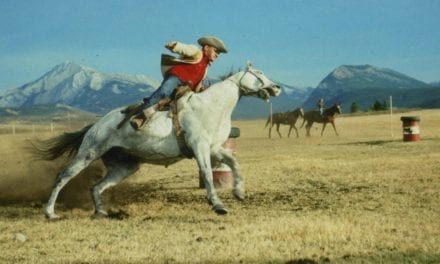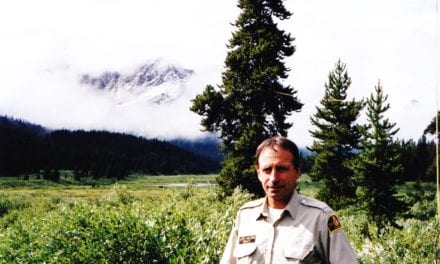(0:25:34) Well, you adapted to it because it was something that you had to do. (In response to the question, “Going back to the mountain climbing, did you eventually enjoy it?) You had to learn and we had the best instructor (Walter Perren) I guess in the world.
(0:26:01) Gordon – He was working for the CPR at the time, guiding. Then they weren’t doing as much guiding for their clients and he had the chance to come over to the Parks.
(0:26:18) That was quite a break for Walter, to go with Parks Canada because at Parks Canada it was the beginning of a very big show…mountain climbing was just developing. When you got roads into Maligne Lake and roads into Jasper from Banff, the Ice Fields Parkway and what not this lead to far more mountain climbing and activities. Of course with activities you get problems! The odd person would fall into a crevasse and you would have to go and fish them out. At the same time that this was happening here we had to take training and buy equipment…nylon ropes…you could pack a good bunch of rope around…Parks bought it, but you had to sign it out.
(0:27:55) Gordon – You had to get your own clothing. This was all starting out and of course you were…the guinea pigs.
(0:28:24) Oh we had one or two (In response to the question, “Are there any rescues or avalanches that stick out in your mind?)
(0:28:36) Gordon – There was one in Yoho with the fellow who killed himself on Mount President and you brought Walter Perren out for that one. We also brought in a helicopter, a small Bell helicopter…I think it was (the first use of a helicopter in a rescue in Yoho).
(0:29:07) Parks Canada more or less pioneered the use of helicopters for mountain rescues. That’s when you learned and you’ll like this expression, “Dangling on the umbilical cord!” Outside of a helicopter flying above a mountain hoping that the string didn’t break!
(0:30:14) There were two or three…we called them Swiss guides, but they were brought over or they came over and got employment with Parks Canada as trainers.
(0:30:37) Gordon – Like Willi Pfisterer and Tony Messner…and Walter. Those were the three originals that I know of. But also some of the wardens like Bert Pittaway were instructors. Warden Toni Klettl was pretty good at mountain climbing and the Assistant Chief Warden at Jasper, he more or less became a ski instructor, but he was also a good climber too. Some of the wardens got to a point where they could start instructing as well.
(0:32:03) Yep, the Palisades (In response to the question, “Did you attend any of the warden schools at Cuthead College or the Palisades?) There was a private ranch within Jasper National Parks and Parks Canada acquired the land which was the Palisades Ranch, which included a housing area, the bunkhouse, the cook shack, the stables and what not. That was converted into a training center for pretty well all of the north western national parks. They brought wardens in from all over.
(0:33:11) Gordon – But they also brought in wardens from the eastern and central parks too, on occasion.
(0:33:22) Like the bunkhouse and cookhouse and whatnot that belonged to this Palisades Ranch were converted into facilities to look after all these wardens that were brought in. It became a major training center for park wardens in for mountain climbing and mountain rescue and fire fighting, you name it. It was a major training center and then they had readymade facilities which required repair and maintenance. So it was an expenditure to keep the facility open.
(0:34:48) Gordon – Cuthead College, they had that mainly for climbing and mountaineering. (In response to the question, “How was Cuthead College different from the Palisades?) They did some other orienteering and that sort of thing…But they had to find different facilities to train wardens in fire fighting and law enforcement and game management.
(0:41:27) Oh yeah! (In response to the question, “Did the warden service change a lot over your career?) It changed. It was based on park use. The more Parks were used, the more the warden service had to expand. The more roads and trails built…national parks became more popular in use and abuse on the other side of the ledger. The more demand there was for looking after the assets so to speak because the public didn’t fight fires, but they set lots of them! They tossed more cigarettes. As traffic and roads improved you got more travel into normally inaccessible places. As the fishing holes became more popular Parks Canada decided that they had to spend a little money and build a road in there. So that changed the whole concept. The more popular it became the more wardens you had to hire to look after it. It was just a circle.
(0:43:17) Well, you had to have (In response to the question, ‘Were part of the changes wanting the wardens to have more formal education?) because you were tending more court cases and you wouldn’t want to get up in court and ask “What’s this all about?” Not only that, but when Parks Canada was recruiting they were recruiting higher educated individuals to look after the court cases and enforce the laws and what not. You read the regulations as they grew. As use grew you had to regulate all these things…You couldn’t drop a bunch of laws on guys who all they could do was fight fire in the summertime and snowshoe around in the wintertime. They had to learn these laws and interpret these laws to enforce them adequately. Not only that, but they had to stand up in court before judges and lawyers to defend the National Parks Act because it was the warden who charged this individual and took him to court. Therefore you had to prove to the judge that your steps were correct. So it was kind of an expansion, learn as you go situation as you went along. Of course if you didn’t take it too seriously or what not you didn’t go too far in the service. But if you looked after your job and did a good job and didn’t offend too many people or put too many people in bankruptcy from fines or in jail you progressed.
(0:47:31) Lots of wildlife stories! (In response to the question, “Do you have any wildlife stories that stick out in your memory?) Once the highways, especially the Trans-Canada Highway from Calgary to Vancouver through Rogers Pass, once that highway got into high gear that changed Banff, Jasper, Yoho and Revelstoke because it was just like a big pipeline. It turned on the flow and the flow was people and automobiles conflicting with the natural scene…We had fires to fight and road kills. That changed the picture. They built a highway down through Banff and Jasper national parks that went right through prime wildlife areas, habitat and breeding…But it didn’t slow down the idiots that were driving the highways even if you did put up the sign “Wildlife Crossing”…that didn’t mean anything to people who were used to driving around Calgary and Edmonton. All they had to be on the lookout for was a policeman to check their speed. Seeing an elk in the ditch, that didn’t mean anything until the elk came partway across the pavement and of course he didn’t have any footing. So halfway across they would fall down and BANG! Run over a big old moose or elk down on the pavement with a car. That happened a number of times and we had pieces to pick up both human and wildlife. Then Parks Canada decided “We better spend some money.” So they found out where these prime wildlife crossing areas were and they put in overpasses for wildlife to cross and tunnels underneath the road. In fact there is a big one…just past Norquay where the sheep had to come down to Vermillion Lakes to the water there to get a drink from the side of the mountain. Here is a paved highway between where the wildlife feeds during the day and (to get) their drink of water they had to cross that blasted highway. That caused problems. We had to put overpasses in and drift fences for the wildlife to come into these crossing areas that Parks Canada set up to cross the highway. But guess what? The foreign visitor to the park was the highway. But you couldn’t say “No, you can’t build a highway through a national park.” They would have had a fit. So they all had to live together in the same world. We had to build all these fancy over and underpasses, at great cost to the public who was financing Parks Canada…
(0:53:45) The next big push of course was to go from Lake Louise to Jasper. So we had to build a highway up through to Jasper. That resulted in a fully paved highway from what we called Lake Louise Junction past Peyto Lake and Bow Lake and Bow Summit and the good old Columbia Icefields. They started operating snowmobiles on the Icefields another tragedy introduced onto the natural scene and so it went. We had the same thing at Maligne Lake in Jasper. They built a trail at Maligne Canyon for hikers to follow the canyon down to where the fish hatchery was…It would take about four or five years, but the whole picture would change like you wouldn’t believe. Of course once the main highways were opened there was more pressure. People wanted to drive up to Maligne Lake, just to see Maligne Lake. Then somebody said “Here’s a chance to make a buck.” So they started running boat tours on Maligne Lake, a great big old natural lake with what they called Spirit Island. The Indians called it Spirit Island because it would disappear and then it would come up. But the island never disappeared. The water was rising and falling. That’s why it was called Spirit Island…
(0:56:21) Helen – 1987 (was the year Murray retired from the warden service) as the head of Visitor Services for Banff National Park. That’s when we moved out here to West Side…
(0:58:00) Gordon – After Jasper you went to Point Pelee, didn’t you?
(0:58:10) Helen – He was the Chief Warden in Point Pelee, that’s what he came down there for. Then back to Yoho. Then we went to Jasper, but we stopped in Banff for a while because there was no house ready for us.
(0:58:26) Gordon – You went there as the Assistant Chief Warden to Banff?
(0:58:32) Helen – Well, I don’t think that they changed his title until he went over to Jasper. He was Visitor Services in Jasper.




Deepest heartfelt sympathy to the Dawson family.
Evelyne Middleton (old Parks Canada Employee-Years to numberous count.